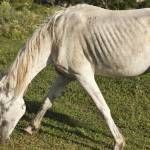Diagnosing Strongyle Infection by Lipidomic Analysis

Within the designation Strongylidae are at least 60 species of equine parasites. Horses with these parasites may show signs such as mild depression, lethargy, diarrhea, colic, and even a fatal wasting syndrome. Small strongyles, or cyathostomes, have third-stage larvae known to migrate into the lining of the horse’s large intestine. Large strongyles like S. vulgaris have third-stage larvae that migrate through the horse’s blood vessels.
Microscopic analysis of equine feces is a common diagnostic technique that can detect larvae as well as eggs from adult strongyle species. This method of detecting parasite infestation is labor-intensive and can have low diagnostic sensitivity. Several other methods are used but no way has yet been developed to detect all important equine parasites in one analysis.
Researchers from the U.K. and China collaborated on a study designed to evaluate the use of metabolomics to find differences in the lipid profiles from strongyle-infected and noninfected horses. They collected samples of feces and blood from 30 horses euthanized at a slaughterhouse for nonresearch purposes. Three analyses were carried out on each fecal sample to determine an average egg count. Serum samples were selected for the five horses with the highest fecal parasite egg counts and six horses with negative egg counts. Lipids were extracted from the serum samples, and lipid chromatography was used to separate different components in the samples. Further analysis resulted in a range of metabolite ratios for the lipid samples.
Results of fecal egg counts showed 22 horses with various levels of strongyle infection, while eight horses were negative for eggs. Ascarid eggs were found in two horses and were the only other indications of parasites. Concentrations of 66 lipid metabolites were significantly different between uninfected horses and those with strongyle infection.
The researchers concluded, “Statistical differences in the concentrations of 66 lipid metabolites between strongyle infected and uninfected horses were observed. These preliminary results demonstrate the potential use of this type of lipid analysis technique for diagnosis of strongyle infection in equids. Further study to assess correlation between lipid concentrations and the intensity of stronglye infection, taking into account exact strongyle species in horses, is required if development of a quantitative diagnostic test is to be achieved.”








